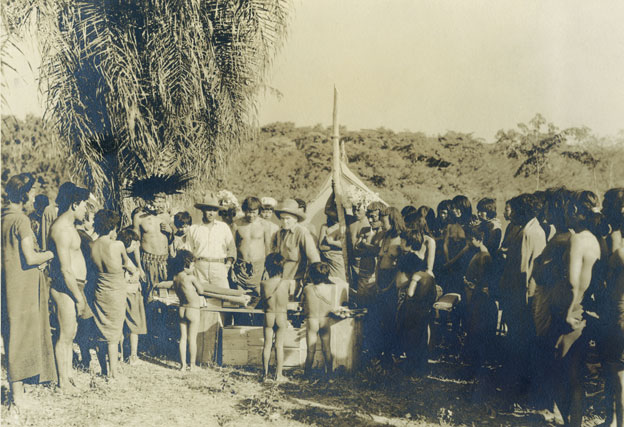
This page includes information that may not reflect the current views and values of the Penn Museum.


MATTO GROSSO
EXPEDITION, Inc.
Sound Moving Pictures : Science : Exploration

In the history of documentary films, Matto Grosso appears to be in the vanguard with regard to sound. Zoran Sinobad at the Library of Congress Motion Picture Division, writes that Matto Grosso would be the first sound documentary film to appear, followed by The Strange Case of Tom Mooney (1933), by Bryan Foy, L.A. Film and Photo League.[1] (For the purpose of this discussion, we are excluding early newsreel productions made by Fox Movietone which used the competing variable density system, and similar newsreel films by Thomas Case and Earl Sponable of President Coolidge (8/11/24) and their early lab experiments). This distinction is based on the precept that news media is by nature temporal, whereas documentary is generally meant to have a longer shelf life.[2]

Further development of film sound technology slowed dramatically after the 1929 stock market crash. It has been theorized that Sam Warner’s urgent and dogged pursuit of sync sound film technology (the Vitaphone system) before the crash cost him his health, (Thrasher, 1946) but made the technology possible. The Depression would have made unlikely the financial investment necessary for the development of these technologies. In fact, a view of the mid 1920’s shows a fevered pitch of engineering activity as all of the competing companies worked night and day to improve their systems in the attempt to corner the production and distribution market. After the crash, sound technology engineering slowed markedly (Atkins/Groves, 1973), and the industry did not see the beginnings of the next major technology, magnetic recording, until the end of WWII.[3] (Mullin, Groves, San Diego, etc.)
After Matto Grosso, the next significant sound documentary films to be made were from the British Documentary Film Movement of the mid 1930’s, (Watt, Night Mail, Wright, Song of Ceylon, et al), which like all of the sound documentaries of the time were made with no recorders in the field. Some wild (non synch) sound effects were recorded in the field, later edited over the picture. The first synch sound documentary films of this movement were Workers & Jobs (1935, Arthur Elton) and Housing Problems (1935, Arthur Elton, Edgar Anstey), which contain brief face to face interviews with public housing tenants in London.[4]

[1]The sync sound portion of The Strange Case of Tom Mooney can be seen on the Internet Archive. The excerpt consists of labor activist, Mooney, speaking about his innocence in a simple, medium close up shot.
[2]There was at least one non-fiction film produced before Matto Grosso that could be said to make significant use of field recorded sound (in this case sound effects of craft and industry); that is, Melodie der Welt (Melody of the World) (1929) by Walther Ruttmann. This was an art/travelogue film juxtaposing similar actions in different cultures around the world. The film was sponsored by a German shipping line and said to have later influenced Dziga Vertov in his impressionist or constructivist use of sound in his art film documentaries, as well as documentarian Joris Ivens.
[3]The next sound recording format was magnetic, the basic format of which was taken as war booty from the Germans by Jack Mullin and others at the end of WWII and developed for use as a radio format with the financial investment of Bing Crosby and others. Crosby’s interest was in not having to broadcast live. He was keen to be able to record in advance and be able to record over previous takes. Around 1955, the magnetic full coat recorder began to appear on the set, not slaved to the camera but synced later with the help of a clapper. The advantages of this were immediately clear, both in the new freedom of the camera and in the ability to have instant playback. The next stage came with the development of the Nagra-Kudelski with crystal sync, (the Nagra IVL) which came in to the market in 1968, but did not appear regularly on movie sets until a few years later.
[4]“The approach to documentary filmmaking adopted by the movement in its early production was socially committed in the sense that the films intended to educate and inform the public. On the other hand, the people who appeared in the films were not speaking about themselves, but someone else was speaking for them. Under these circumstances they seemed distant….Although the facilities for synchronized sound existed at that time, the unit was forced to use non-sync sound because of its cumbersome and inferior sound system.” http://www.lib.berkeley.edu/MRC/gpo.html
